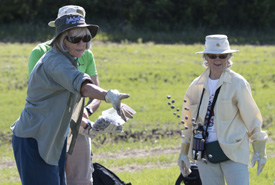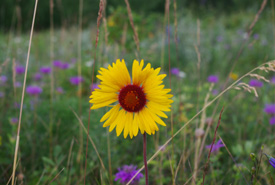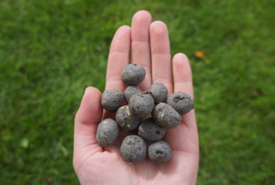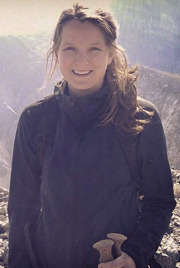Bombs away...Seed bombs, that is!

Volunteer throwing seed bombs into experimental test plot at Conservation Volunteers event in Alberta. (Photo by NCC)
Do you have a patch of hard–to-reach garden space? What about an exposed piece of earth that you’d like to restore to native vegetation? Or perhaps you are simply looking for an enjoyable, hands-on activity for you and your family to do in the garden. Seed bombs are a fun and simple way to "greenify" a space, with multiple benefits including aesthetic and ecological. See below for the recipe or check out the video tutorial at the end of this post!
Seed bombs consist of soil, clay and native seed. It's as easy as 1, 2, 3! The soil provides the nutrients the seeds need to start growing, and the clay helps to hold everything together and protect the seeds from being blown or washed away.
It is extremely important that when choosing the seed to use in your seed bombs, you are choosing a plant that is indigenous to your local environment. There is a wide range of wildflowers and grasses native to specific areas of Canada, so the options are varied; but be sure you are planting native seed.
Ensure you are obtaining the seed from a sustainable and environmentally friendly source. Your local native seed provider is a good place to start! Consult your local Invasive Species Council (there’s one in each province) for more information and tips regarding which species are native in your area.

Gaillardia (Photo by NCC)
Native plants pose many advantages over invasive plant species. For one, they help to encourage and sustain biodiversity. Many ornamentals have been introduced from lands thousands of kilometres away and may exhibit invasive characteristics in our local soils.
Although not all non-native plants will exhibit these qualities in a garden, there is potential for these non-native seeds to escape into the wild, where they could wreak havoc. Invasive plant seeds can spread vast distances via wind and animals, on vehicles or on shoes. Thus by planting native, non-invasive plants in our gardens and urban environments, we are taking a step towards reducing the expansion of invasive species in the wild and protecting biodiversity in our natural areas.
Furthermore, native plants have adapted to their local climate, hydrology and geography over time. Once established, native plants require less water, provide habitat for native pollinators such as insects and birds, and can even help deter pests such as ants or aphids.
Non-native invasive plants will compete against native plants for sunlight, water and nutrients. When invasive species are present, they can take over local habitats, decreasing the amount of biodiversity and making it extremely difficult for the native species to thrive.
In addition, non-native plants often have no naturally occurring diseases or predators, which normally act as population control tools. This exacerbates the problem and gives them a severe growth advantage over native species.
For more information on naturalizing your garden, check out our native gardening page.
Native plants allow for the favourable conditions for establishment of a native plant community, maintaining that high level of biodiversity which we want to see. And, native wildflowers can be extremely beautiful and appealing, not only to us but also to local wildlife. A native plant garden will attract an abundance of native fauna, adding to its ecological and aesthetic value!

Gaillardia seed bombs (Photo by NCC)
Seed bombs are an excellent tool to teach about the importance of native species and a great way to get kids excited about nature! Here in Alberta, our Conservation Volunteers helped to distribute more than 4,000 seed bombs using seed from seven species of native wildflowers. It was all part of an experimental test plot with the hopes of engaging the community and local future scientists in monitoring and learning about invasive species.
Many of our Conservation Volunteers events welcome children, and it’s a great way to meet other like-minded individuals. We would love to meet you and hear how the seed bomb making went!
To learn about the events happening in your area, visit the Conservation Volunteers page on our website.
(Video editing by Kyle Meller.)
Seed bomb ingredients:
- ¾ cup of soil or compost
- ¾ cup wet clay*
- 3–5 native seeds per seed bomb**
*Check your local arts store for wet potter’s clay. It is also possible to use powdered clay and add water at approximately a 5:1 ratio of clay to water. Add water as needed, just enough so it becomes a thick paste.
**Check your local native seed provider for seeds sourced from local environments in an environmentally friendly manner.
Step 1: Add the wet clay and soil to a large mixing bowl.
Step 2: Use your hands to mix these two ingredients thoroughly. Don’t be afraid to get dirty!
Step 3: Once blended, pinch off approximately one teaspoon worth of dough and add three to five native seeds per seed bomb.
Step 4: Combine the seeds into the mixture by rolling it together in your palms to form a small ball, just like you’re making cookies! Your seed bombs should be about the size of a marble.
Step 5: Place the seed bomb aside to dry, and repeat starting from Step 3. Once all the mixture is rolled out, you should have about 100–150 seed bombs.
Step 6: It is then time to plant. Bombs away! Plant your seed bombs simply by throwing them or placing them in hard to reach areas of your garden. This is a good excuse to finally clear those pesky weeds from your garden to make way for fresh native plants!
It is important however that you ensure you have permission before planting. There is no need to water your seed bombs once planted; just wait for the rain and nature to work their magic! Happy seed bomb making!


